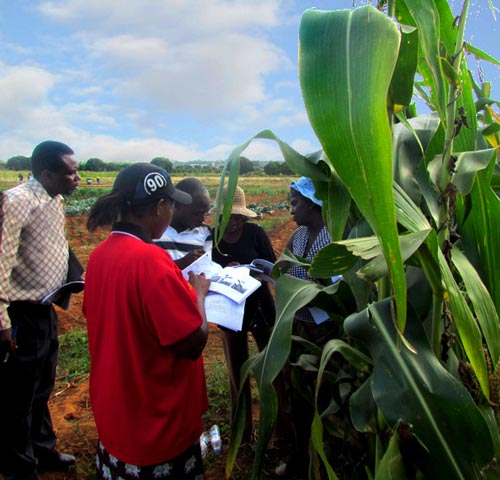 During the week of 15-20 April 2012, 36 maize technicians participated in a training session in Lusaka, Zambia. The participants were selected from seven seed companies in Zambia, national agricultural research organizations, and NGOs involved in agricultural research and extension in the eastern province of Zambia. The objective of the course was to update maize technical staff on implementing on-station and on-farm trials, seed production, and the use of secondary traits in selecting superior genotypes under low nitrogen, heat and drought trials, and it combined both lectures and field work.
During the week of 15-20 April 2012, 36 maize technicians participated in a training session in Lusaka, Zambia. The participants were selected from seven seed companies in Zambia, national agricultural research organizations, and NGOs involved in agricultural research and extension in the eastern province of Zambia. The objective of the course was to update maize technical staff on implementing on-station and on-farm trials, seed production, and the use of secondary traits in selecting superior genotypes under low nitrogen, heat and drought trials, and it combined both lectures and field work.
Well-managed experiments provide the foundation of all research towards germplasm improvement. Technicians are responsible for many day-today field activities and much agronomic management, making their training crucial in strengthening the capacity of national programs. The course was organized by three CIMMYT projects—Drought Tolerant Maize for Africa (DTMA), Sustainable Intensification of Maize-Legume Systems for the Eastern Province of Zambia (SIMLEZA) and Improved Maize for African Soils (IMAS.—in collaboration with the Zambian Agricultural Research Institute (ZARI). It was designed to give technicians greater insight into key processes within germplasm development, variety testing and release, and seed production. Emphasis was given to the importance of trial uniformity, good agronomic management practices, and standardizing measurements.
Each project contributed specialized content to the course: under DTMA the focus was on how to select genotypes under managed drought and heat stress, develop a seed production strategy using seed road maps and maintain trial uniformity. The SIMLEZA project emphasized on-farm testing using the Mother-Baby Trial approach while under IMAS the emphasis was on developing low nitrogen sites and important traits to select for production under low nitrogen. CIMMYT thanks the course organizers and resource persons, Kambambe Mwansa and Franscico Miti of the Zambian Agricultural Research Institute, and CIMMYT’s Peter Setimela, Jill Cairns, Biswanath Das and Sebastian Mawere.
 Capacity development
Capacity development 
